WILLIAM A. GUTHRIE & THE GUTHRIE TRAIL
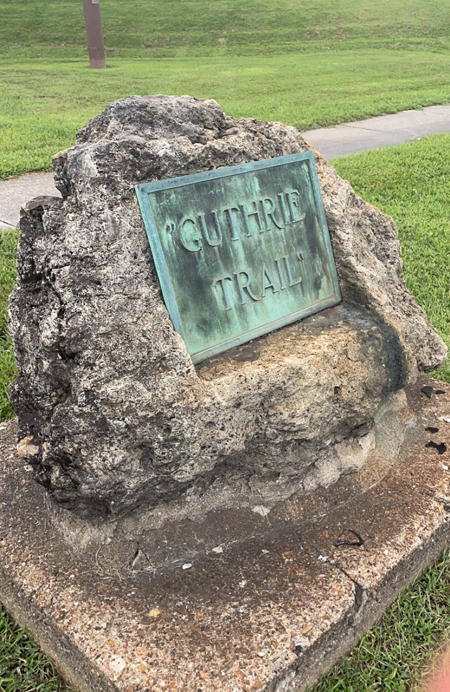
What does this large rock marker near the intersection of State Highways 3 & 7 and U.S. Highway 50 signify?
In the 1920's the prosperity of the smaller communities hinged upon how accessible they were by the ever growing network of highways. If your town was bypassed by these roads, the main mode of travel by most citizens, it would mean your potential for growth was diminished. This meant routes for these highways became politically important. When it was decided that a state highway was to be built going from the Ohio River at Madison to Indianapolis and on to Michigan City on Lake Michigan its route was critical for towns along its path. The southern part of the road had two main route choices to be built as State Highways. One followed the route of the "Old Michigan Road" and bypassed Jennings County, the other came from Indianapolis to Columbus then on through North Vernon to Madison. These route choices were hotly contested and promoted by towns along both possibilities. Locally it got so bad that the town of Dupont considered becoming part of Jennings County because the political powers in Madison promoted the more eastern route which left out the small towns between Columbus and Madison, of which Dupont was one.
One of the main people who stepped into this battle was William A. Guthrie who worked in conjunction with North Vernon, Madison & Columbus citizens to get the route designated as a state highway after the "Old Michigan Road" had been chosen first for improvement. At the time he did this he was a member of the State Board of Conservation and had many political ties in Indianapolis but his main home was near Dupont.
This marker naming the section of road between Columbus and Madison "The Guthrie Trail" was in appreciation for his assistance.
The following information on William Anderson Guthrie is from Gray File Box #59, File #2051 at the Jennings County Public Library.
Information received orally from Mr. Guthrie's niece, Miss Marjorie Lewis on August 21, 1969
At the time the state planned to build a road from Indianapolis to Madison, Madison agitated for the route through Greensburg down the Michigan Hill, using the argument that the road should follow the Old Michigan Road for sentimental reasons. Columbus and N. Vernon wanted the road to pass through their respective cities and enlisted the aid of Mr. William Anderson Guthrie. Mr. Guthrie was able to persuade the road so both one following the Michigan Road and Highway 7 were built. In gratitude to Mr. Guthrie a marker was placed at Columbus and N. Vernon, designating the road as the Guthrie Trail. There is no marker at Madison.
Mr. Guthrie is buried at Dupont, Indiana.
Information obtained from Who's Who in America, 1934-35, Vol. 18.
Guthrie, William Anderson, Capitalist; born near Dupont, Ind., May 13, 1851; son of Anderson Crawford and Ann (Wilson) Guthrie.
Member State Senate of Indiana, 1900-1904. Home: Dupont, Ind.Office: Columbia Club, Indianapolis, Ind.
(Detailed information regarding activities may be found in the above article.)
Who's Who in America, 1938-1939
Mr. Guthrie Died August 5, 1936
INDIANA (BIOGRAPHY Page 194)
William A. Guthrie was born in Jefferson County, Indiana, May 13, 1851. He grew up on a farm attended schools at College Hill (Lancaster) and Moore's Hill (Dearborn County). On October 28, 1875 he married Miss Sarah Lewis, daughter of Dr. George Brown Lewis, at Dupont, Indiana.In Politics he is a Republican. In 1898 he was elected to the State Senate from Jefferson, Ripley and Switzerland, counties, being one of the ablest members of that body during the sessions of 1898 and 1901. A distinction that will long attach to his name was the credit for introducing and bringing about passage of the first and present pure food law. This law corresponds in all important essentials to the national food law, and both measures were written by the eminent Dr. Harvy Wiley. Mr. Guthrie was delegate to the Republican National Convention from his home district in 1908 and 1916 was presidential elector. He was appointed by Governor Ralston and reappointed by Governor Goodrich a member of the state forestry commission.
Governor Goodrich appointed him on the Food Production and Conservation committee.
From: INDIANA-Volume III, Page 494
The INDIANA HISTORY BULLETIN March 1966 states: The Guthrie Trail Marker is erected at Walnut and State Streets in North Vernon, Jennings County. It was erected by the Chamber of Commerce in 1921.From the NORRIS scrapbook:
"North Vernon, Indiana. September 24, 19-(?)The North Vernon Chamber of Commerce has completed the placing of three markers along the north and south highway. One marker was placed at North Madison, one in this city and one at Columbus, Indiana.
The markers rest on a cement base, are of stone, and weigh three tons each. They were obtained on the N. E. Smith farm in Bigger Township and were supposed to have been formed during the glacial period.
Shortly after the north and south highway from Madison to Columbus had been designated by the state highway commission, the Chamber of Commerce by resolution asked that body to name the route the "GUTHRIE Trail, in honor of William A. Guthrie, of Indianapolis and Dupont, a member of the state board of conservation, and who worked in conjunction with Madison, North Vernon and Columbus citizens in obtaining the highway. The board finally consented and the markers, paid for by the Chamber of Commerce were the result." An old newspaper clipping. 1921(?)
A Clipping From The Guthrie Library File

Guthrie Genealogy from Library File
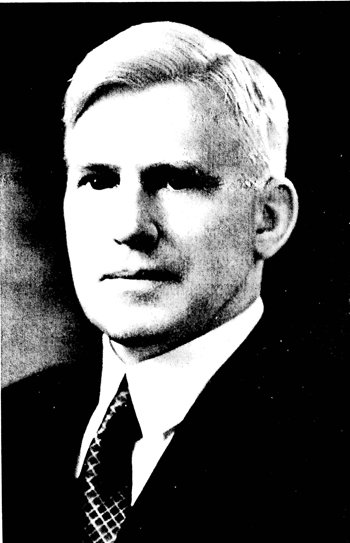 Clarence R. Guthrie |
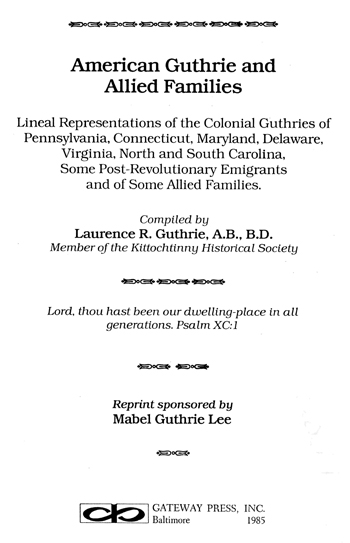 |
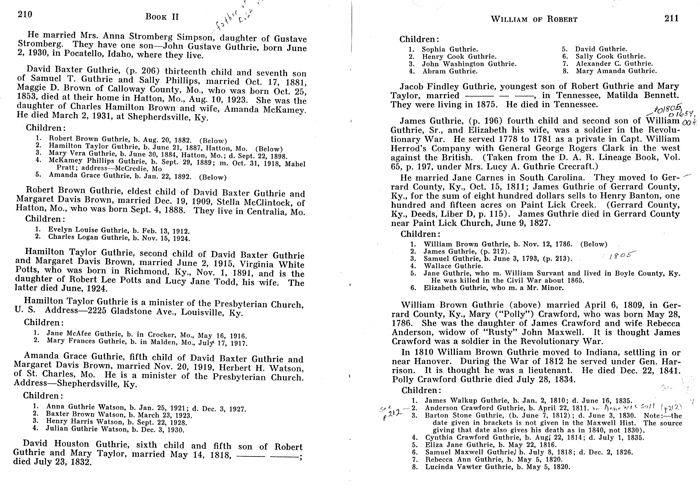
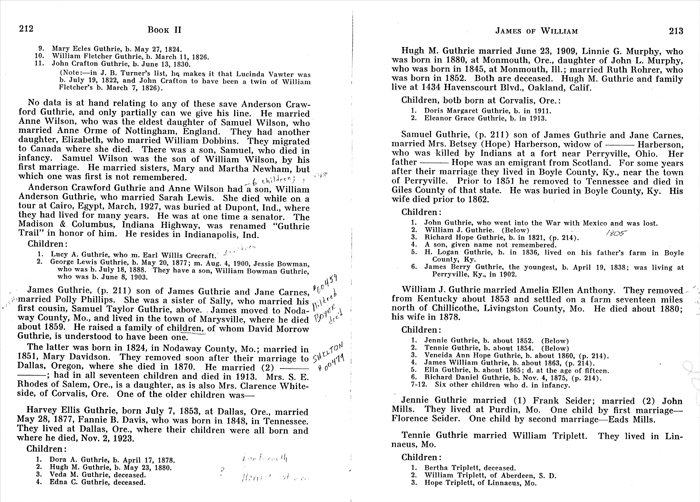
Another File in the Jennings County Library Folder,
no author given (it was written while William Anderson Guthrie and his wife were still living.)
no author given (it was written while William Anderson Guthrie and his wife were still living.)
WIILLIAM A. GUTHRIE,
William A. Guthrie whose home is at Dupont, Indiana, but whose prominent business and civic interests require much of his time at Indianapolis, has been more than a representative Indianan for many years and is a worthy descendant of a long line of patriotic and substantial ancestry. The Guthries have resided in the United States for many generations and have taken high rank in education, industry, material wealth and citizenship.
The original home of this family was in Scotland. Thomas Guthrie, of Scotland, was one of the more noted of the name. He founded the famous "Raggedy Schools" of Edingurgh, and was widely known as a scholar, orator and philanthropist. Lord Charles Guthrie, present owner of the Robert Louis Stevenson home at Edinburgh and a son of Thomas Guthrie just mentioned, is probably the most widely known member of the family in Europe.
The Americans of the name are probably all descended from William Guthrie. He was a planter and slave owner in South Carolina, being one of the first settlers in the Waxham district. One of his descendants was James Guthrie of Louisville, Kentucky who served his state in the United States Senate and was also a cabinet officer. Another direct descendant of the William Guthrie of South Carolina was James Guthrie, who served the colonies in the Revolutionary war. He married Jane Carnes, daughter of Alexander Carnes.
Page 2
William Brown Guthrie, son of James and Jane (Carnes) Guthrie, was born in South Carolina and moved to Kentucky during the time of Daniel Boone. He there married Polly Crawford, daughter of James and Rebecca (Anderson) Crawford. The Andersons were also from Scotland, but on coming to America settled in old Augusta county, Virginia, where their names occur frequently among old records and deeds. Rev. James Anderson, a Presbyterian minister, was a progenitor of the family in America. He too served in the Revolution.
William Brown Guthrie had an interesting career. While serving the colonies in their second struggle with Great Britain, his wife, then living in Jefferson county, Indiana, was compelled to flee from home to escape an Indian raid. She carried one small child in her arms and led another by the hand, and after many miles of travel finally reached the safety of a blockhouse. William Brown Guthrie died and is buried in Hanover, Indiana.
Anderson Crawford Guthrie is next in direct line. He was the child carried in arms by his mother to escape the Indians. He was born April 22, 1811, in Jefferson county, Indiana. A farmer by occupation. He also taught school, and while in that occupation met and married Anne Wilson. She was born in Nottingham England, in 1815, and came with her parents, Captain Samuel and Anne (Orme) Wilson, to the United States in 1820, Captain Wilson
Page 3
Was trained to arms in England, and because of that experience drilled a company of Americans and was thus invariably called Captain.
Anderson Crawford Guthrie was a man of superior mental attainments. Politically he was identified with the republican party from the time of its organization, and was a man of highest esteem. He died in 1866, his widow surviving until 1901. They had six children: Mary Anne, Elizabeth Jane, Sarah Lucinda, Samuel Wilson, who was a soldier in the Civil war, Ruhamah, and William Anderson.
William Anderson Guthrie, whose ancestry has thus been briefly traced, was born in Jefferson county, Indiana, May 13, 1851. He grew up on a farm and has always kept in touch with the agricultural interests in the southern section of the state. He attended schools at College Hill and Moore's Hill. On October 28, 1875, he married Miss Sarah Lewis, daughter of Dr. George Brown Lewis, at Dupont, Indiana.
Despite his large business interests, centered at Indianapolis, William A. Guthrie still maintained his home at Dupont, in Jefferson county. In politics he was a republican. In 1898 he was elected to the State Senate from Jefferson, Ripley and Switzerland counties, being one of the ablest members of that body during the sessions of 1899 and 1901. A distinction will long attach
Page 4
To his name was the credit for introducing and bringing about the first and present pure food law. This law corresponds in all important essentials to the National food law, and both measures were written by the eminent Dr. Harvey Wiley. Mr. Guthrie was a delegate to the Republican National Convention from his home district in 1908 and in 1918 was a presidential elector. He was appointed by Governor Ralston and reappointed by Governor Goodrich, a member of the state forestry commission and has been its President all the time since a member.
Governor Goodrich appointed him on the food production and Conservation Committee. He is a thirty-second degree Scottish Rite Mason, a Noble of the Mystic Shrine and a member of the Columbia Club of Indianapolis.
Mr. and Mrs. Guthrie are the parents of two children, Dr. George Lewis Guthrie and Lucy Anne Guthrie. Dr. George L. Guthrie us a graduate of the Indiana Medical College, was the third vice president of the Indiana State Medical Association, and now holds a Majors Commission in the United States Medical Reserve Corps. On his return from the war zone in France, he was assigned Post Surgeon at Fort Ethan-Allen, Vermont. He married Jessie Fremont Bowman, a graduate of Shortridge High School and before her marriage a teacher in the Indianapolis schools. Dr. and Mrs. Guthrie have one son, William
Page 5
Bowman Guthrie. Lucy Anne Guthrie is a graduate of the Shortridge High School and of Franklin College, received her musical education Cincinnati College of Music and New York. She married Dr. E. W. Crecraft, and their three children are named Lucy Anne, Jane Willis and Richard Guthrie. Dr. Crecraft is a graduate of Franklin College and of Columbia University, attaining his Philosophy degree from the latter institution. He is now a lecturer on international law and politics in New York University.
Among the prominent Indiana women of the present generation Mrs. William A. Guthrie is widely known. She is the Indiana State Regent of the Daughters of the Union, is state Secretary of the Indiana Daughters of the War of 1812, and is honorary state regent of the Daughters of the American Revolution having served State Regent three years and is now one of the Vice President Generals National Society, D. A. R.
Another Clipping from the Library file with no paper name or date
Mr. William A. Guthrie has provided a lasting and appropriate memorial to his wife, the late Sarah Lewis Guthrie, by donating to the Nature Study Club of Indiana a tract of more than sixty acres near
Dupont (In Jennings County) to be preserved for the study of plant and animal life. The ground is heavily wooded and it is provided in the truat dead that none of the trees may be cut down. The gift is to provide, as Mr. Guthrie
points out, "suitable and adequate land for the study and development of Indiana's native timber and to provide for its growth in a natural and inexpensive way." Mr. Guthrie was for many years a member of the state conservation
commission and has taken an active part in the preservation of the resources and natural beauty spots of Indiana. It was, therefore, most appropriate that he should provide as a memorial to his wife a tract that would be a perpetual,
object lesson and source of interest to those concerned in nature study.GUTHRIES GIFT IS FOREST PRESERVE
Nature Study Club Receives Tract of Land Near Dupont for Nature Sanctuary.
As a memorial to his wife, Mrs. Sarah Lewis Guthrie, Indiana clubwoman who was active in patriotic organizations and who was known as a lover of natural beauties of Indiana. William A. Guthrie, a wealthy conservationist, businessman and former state senator has announced the conveyance by trust deed to the Nature Study club of Indiana near the Guthrie home at Dupont, Ind., which contains an abundance of botanical specimens and wildlife in its expanse of 61.61 acres.
The gift has been received by Charles J. Buchanan, president of the Nature Study club, and its membership of more than 440 persons, who value this as a natural laboratory for the study of wild life. The governing board of the club has signed an agreement to the terms of the trust conveyance, which among other things specifies that no tree shall ever be cut down in the preserve or any of its wild life destroyed so long as the club or any nature study organization that might succeed it is in possession.
The woodland is one which Mrs. Guthrie inherited from her father, Dr. George B. Lewis, a pioneer physician of Jefferson County, who settled in Indiana in 1851. At the death of Mrs. Guthrie, March 5, this year, at Cairo, Eqypt, while on a Mediterranean cruise, (this gives us the year this was written as Sarah Guthrie died in 1927), the property passed to her children and husband. Mr. Guthrie bought the interest of his children after he conceived the idea of establishing a living and everlasting memorial to his wife which would be useful to natural science and tree conservation-subjects that had been of deep interest to them for many years.
"The object and purpose of the gift and settlement in trust," the deed says, "is to provide suitable and adequate land for study and development of the native Indiana timbers and to provide for its growth in a natural and inexpensive manner to demonstrate to this and to succeeding generations of our citizenry that lands in this state without much or extensive preparation but in natural and simple manner under ordinary condition can be made to grow and produce trees and timbers and are useful and valuable and become increasingly valuable and profitable from year to year."
The Nature Study club of Indiana is to have, to hold and to control the land for these purposes, the deed asserts, and "to let the trees grow into sizeable and mature timbers, to keep records as to their growth and botanical development that may be used in instruction and education of the general public as to feasibility, usefulness and profit of allowing and providing for the growing of trees to the end that reforestation for commercial purposes may be advanced."
Natural hardwood trees for which Indiana was once famous the world over form a dense second growth forest on the preserve. Large trees of the original forest have been cut from it, but for ten years the tract has been allowed to grow wild until today (1927) it is almost impenetrable. The woodlot lies near state road No. 7, one and one-half miles north of Dupont on the line which separates Jefferson and Jennings counties. The trees have from ten to twenty years growth and it has been estimated that there are 700 of them to the acre or more than 40,000 in the woodlot. The ten years frowth of most of the trees has been so astonishing that experts believe the land covered by the forest is unequaled for tree growth by any other soil in Indiana. It is high round, with a light, gray soil. In an adjoining tract trees which are only fifty-two years old are as large as those which were cut from the original forest, old settlers say. White oak, yellow popular, hickory, gum, maple and other varieties of hardwood trees native to Indiana, are found growing in the preserve.
Direct conveyance of the woodland was made for the considerations of "love and affection for Mrs. Guthrie" and as a memorial in her honor to the Madison Safe Deposit and Trust company, as trustee for the Nature Study club, with the John Paul chapter, 578, Daughters of the American Revolution of Madison designated a "board of visitors," empowered to report annually to the trustee on the condition of the memorial woodland and to advise with the trustee and benefactors on the upkeep and protection of the tract.
The honor bestowed on the Madison chapter of the D. A. R. is a further tribute to the memory of Mrs. Guthrie who rose to the office of vice-president-general in the national councils of the patriotic organization. Mrs. Guthrie was regent of the D. A. R. when the John Paul chapter was founded and later became state regent of the society and more recently held national office. She was a great granddaughter of Darby McGannon, who fought in the American revolution. Other patriotic and historical organizations in which Mrs. Guthrie was a recognized leader and organizer of ability were: The Daughters of the Union; The Daughters of 1812; The Jefferson County Historical Society; The Indiana Society of Pioneers; the Colonial Dames and the Nature Study club. She and Mr. Guthrie were amont the first advocates of the restoration of the Lanier mansion by the state and the establishiment of Clifty Falls state park.
Mrs. Guthrie was an ardent admirer of flowers. The rooms of her country home at Dupont and suite in the Columbia club at Indianapolis were always filled with fragrant boquets. She devoted most of her spare time with the cultivation of a flower garden. Her second love, however, were the native trees of Indiana. She was fascinated by the nobility of the forests and often would leave her suite of rooms in Indianapolis to return for "a visit with the trees" of Jefferson county, where she and Mr. Guthrie were born and reared. It is recalled by Mr. Guthrie that on one of their many trips abroad, Mrs. Guthrie, while in Germany, expressed suddenly one day weariness at seeing so many cathedrals and man-erected edifices and confessed a feeling of homesickness to see again the trees that God made in Indiana. She subscribed fully to the sentiment of the poet, who said, "Only God can make a tree." ( by Poet Joyce Kilmer, first published in 1913.)
The Nature Study club may build a cabin at the Sarah Lewis Guthrie memorial, such as it has on it's two other reservations. The club owns a two-story cottage in the hills of Brown county, six miles southwest of Nashville on the state game reserve. It also has a cabin in Woollen's gardens northeast of Indianapolis, near the Boy Scout reservation. This is known as Buzzard's Roost. The club was founded about twenty years ago by William Watson Woollen, father of Evans Woollen, president of the Fletcher Savings and Trust company, and a group of nature lovers. Dr. Frank B. Wynn, physician and naturalist who lost his life in mountain climbing, was second president of the club, succeeding Mr. Woollen. Robert C. McBride was third president and Samuel Elliott Perkins III was the fourth. Mr. Buchanan, who now is president, is the fifth to hold the office.
The club has departments which care for the specialties of its members. Among the departments are those on astronomy, birds and animals, another on butterflies, bees, beetles and bugs; another on bird-banding, botany, camps and trails, forestry, heology and archaeology, music, photography and history. Trips are taken by members to distant places and into all parts of Indiana each year. Last year a party of twenty-eight persons went to Alaska. This year another party went to Zion canyon, Arizona. The club was largely responsible for action by the state department of conservation establishing the Dunes state park and Turkey Run state park. With the new forest preserve in its possession the club may take steps to open its membership to citizens in Indiana.
Madison Courier - May 15, 1948
The life of the late Senator William A. Guthrie was the subject of a prize winning paper submitted by Lois Anne Rodert, a junior in Dupont high school, who was a successful competitor in a recent essay contest arranged by the Jefferson County Historical Society. Her paper follows:
WILLIAM A. GUTHRIE
William A. Guthrie was born May 13, 1851, on the farm where Howard Hinds now lives at Dupont. He was the son Anderson and Ann Guthrie of Scotch ancestry. He attended College Hill at Lancaster and Moores Hill college, the latter now Evansville College.
In 1875 he was married to Miss Sarah Lewis, descendant of an old Jefferson county family. They then moved to Dupont. Two children were born to this union. Dr. George Guthrie, who preceded him in death, and Lucy Crecraft, wife of Dr. Earl Crecraft of Kent, Ohio.
Mr. Guthrie was a farmer and timber man. He bought tracts of timber all over the county and was very interested in other lines of business. Mr. Guthrie was also a shrewd business man. He was a devoted husband and father. He also built a modern home in Dupont to please his wife. It was a place for their children and grand-children to come for 13 years.
This couple made two trips abroad to England, France, Switzerland, Germany, Holland and Italy. While on their trip to Cairo, Egypt, in 1925, Mrs. Guthrie died.
Mr. Guthrie had been prominent in Indiana republican politics and was widely known for his work in the State Conservation Commission. He was appointed to the commission in 1919, and during his seven years tenure, McCormick's Creek, Turkey Run, Clifty Falls and the first units of the Dunes State Parks were added to the state's holding.
The "Guthrie Trail" leading from Madison around under Hanging Rock through Dupont and northward to Indianapolis is named for him in honor of his work in improving highways. When he reached his eighty-fifth birthday a plaque was placed at the entrance to Clifty Falls Park, commemorating his service. Mr. Guthrie likewise sponsored restorations of the old Lanier home in Madison.
Mr. Guthrie, associated with a small group of state senators, effected the first election of the late Albert J. Beverage as United States Senator. At one time he was township trustee. Then he was sent to legislature twice. He was then elected joint-senator from this county. While he was in the legislature he was instrumental in getting money to help restore the Lanier home.
His service with the republican party included being a delegate to the 1908 national convention. In 1916 and 1928 he was presidential elector. He was then sent to Washington D. C. and British Columbia Canada to get information for Governor Goodrich. Mr. Guthrie was vice-president of food production in the state during the first world war, and subsequently he became vice-president of the Indiana Deep Waterway Commission.
Much of the time he lived at the Columbia Club in Indianapolis, but many of his interests lay in Lancaster township and Jefferson County. He was vice-president of the Belt Railroad and Stockyards company; vice-president of the Fletcher Avenue Savings and Load association; vice-president of the Guthrie-Thompson, contractor, the Federal Timber compand and the Florida company; He was president of the Freehold company and a director of the the Union Land and Timber company, and of the National Branch Bank in Madison.
He held membership in the Academy of Science, the Rotary Club of Madison, The Nature Study club of Indiana, the Masonic and Odd Fellows lodges, the Audubon Society, the Pioneer Society of Indiana, the Jefferson County Historical Society, and the Dupont Baptist church to which he was a generous contributor. He financed half of the funds for the first parsonage.
Mr. Guthrie was a type of Hoosier of whom the township and county is proud-solid, genuine, and of strong character. He died August 5, 1936.
LOIS ANNE RODERT
Dupont High School,
Dupont, Indiana,
Grade 11
THE GUTHRIE TRAIL
November 25, 1920 - North Vernon Sun
It seems very probable the state road from Madison to Indianapolis will be named the "The Guthrie Trial"
in honor of William A. Guthrie, of Dupont, who worked faithfully to get the state highway to Madison. In appreciation of Mr.
Guthrie's efforts the local Chamber of Commerce has passed a resolution urging the highway commission to name the road "The Guthrie Trail".November 25, 1920 - North Vernon Sun
O. R. Platter, president of the Chamber of Commerce has mailed the resolution adopted to both Mr. Guthrie and Governor Goodrich. In reply Goodrich said:
"I have your letter of the 15th enclosing copy of your resolution. Senator Guthrie deserves every word you say about him and more too. Had it not been for his persistent and untiring efforts in behalf of the state road, it is very doubtful if it would ever have been established.
Mr. Guthrie's letter follows:
"Received yours of the 13th with enclosed resolutions, passed by your Chamber of Commerce.
"I cannot help but feel gratified and complimented by your action. One to impress his work in such a way that his name should be mentioned in connection with such a prominent undertaking is sure pleasing.
"This however to me is not the most that Jennings County people have done. You not only helped with the part of the road you were most interested in and did get, but seemed just as anxious and willing to have the State road continued to help me.
"Your actions in standing by me until we got the part I was most interested in, is what I appreciate most. It shows your true spirit.
"I was only one cog in the wheel to move the machine that put this over, all helped and were necessary to do it, but Mr. Platter you were my greatest assistance.
"May we all work together to accomplish greater things in Southern Indiana."
GUTHRIE TRAIL MARKER PLACED
July 16, 1921 - The Columbus Republic
The Guthrie trail, extending between this city and Madison, was marked at its entrance to this city today when
a large bronze tablet was put in place two miles east of the city. Dr. N. M. King, of North Vernon, was here today to superintend the finishing
of the marker. The plate was embedded in a stone weighing more than two tons and the stone itself was placed on a large concrete base. The marker
is one of three which marks the Guthrie trail.July 16, 1921 - The Columbus Republic
The North Vernon Chamber of Commerce sponsored the movement to have the trail marked and Dr. King expressed his thanks for the aid it has received from local persons. Frank Hardin, county highway superintendent, constructed the concrete base, and George Unger, of the Unger monument works had the place set in the stone. The stone is a piece of glacial rock obtained from the southern part of Jennings county. The Guthrie trail was given its name in honor of ex-Senator Guthrie who was influential in having the road made a part of the state highway.
You may use this material for your own personal research, however it may not be used for commercial publications without express written consent of the contributor, INGenWeb, and